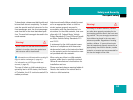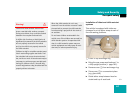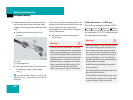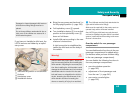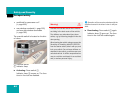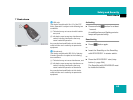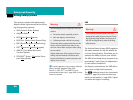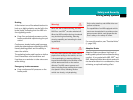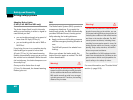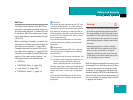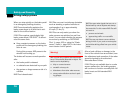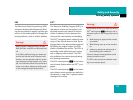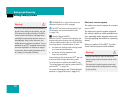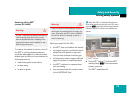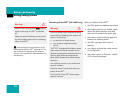
67
Safety and Security
Driving safety systems
Braking
At the instant one of the wheels is about to
lock up, a slight pulsation can be felt in the
brake pedal, indicating that the ABS is in
the regulating mode.
̈ Keep firm and steady pressure on the
brake pedal while experiencing the pul-
sation.
Continuous, steady brake pedal pressure
yields the advantages provided by the ABS,
namely braking power and the ability to
steer the vehicle.
The pulsating brake pedal can be an indica-
tion of hazardous road conditions and
functions as a reminder to take extra care
while driving.
Emergency brake maneuver
̈ Keep continuous full pressure on the
brake pedal.
For more information, see “Practical hints”
(
୴ page 598).
Adaptive Brake
Adaptive Brake provides a high level of
braking safety as well as increased braking
comfort. It is coupled with ABS, ESP
®
and
BAS. Adaptive Brake takes driver and vehi-
cle characteristics into consideration, thus
achieving an optimal braking effect.
Warning! G
When the ABS is malfunctioning, the BAS,
BAS Plus* and ESP
®
are also switched off.
When the ABS is malfunctioning, the wheels
may lock during hard braking, reducing
steering capability and extending the brak-
ing distance.
Warning! G
The ABS cannot prevent the natural laws of
physics from acting on the vehicle, nor can
it increase braking or steering efficiency
beyond that afforded by the condition of the
vehicle brakes and tires or the traction
afforded. The ABS cannot prevent acci-
dents, including those resulting from exces-
sive speed in turns, following another
vehicle too closely, or hydroplaning.
Only a safe, attentive, and skillful driver can
prevent accidents.
The capabilities of an ABS equipped vehicle
must never be exploited in a reckless or dan-
gerous manner which could jeopardize the
user’s safety or the safety of others.



